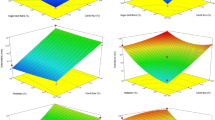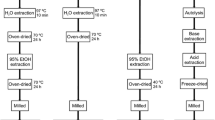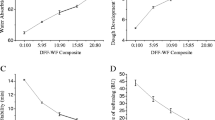Abstract
Distiller’s grains, by-product from ethanol production, can be a new source for nutritionally enriched bakery products, particularly because of its high amount of dietary fibre and protein. Ingredients rich in fibre provoke challenges to the dough and bread system; therefore, mechanisms behind dried distiller’s grains (DDGs) impact on wheat bread must be evaluated. So, dough and bread characteristics were analysed in bread containing 0–20 % DDG, and effects of pH, particle size and furfural as DDG metabolite were studied. As a result, wheat bread incorporating DDG provides smaller volume from 20 to 45 %, firmer crumb up to a factor of 6 and reduced springiness up to 10 %. However, pH adjustment balanced the negative influence, and the low pH of DDG was revealed as the most influential parameter. The variation of particle sizes could not influence dough or bread characteristics significantly. While the low pH of DDG and the high amount of dietary fibre do not completely explain the negative impacts, inhibiting effects on the activity of Saccharomyces cerevisiae were evaluated. DDGs contain 2.7 ppm furfural as a consequence of the drying process, so its role as inhibiting compound was investigated in a model suspension and dough. It was confirmed that furfural is contributing to structure weakening effects in dough.



Similar content being viewed by others
Abbreviations
- AACC:
-
American Association of Cereal Chemists
- Ba(OH)2 :
-
Barium hydroxide
- BaCO3 :
-
Barium carbonate
- BSG:
-
Brewers spent grain
- CO2 :
-
Carbon dioxide
- DG:
-
Distiller’s grains
- DDG:
-
Dried distiller’s grains
- DDT:
-
Dough development time
- DS:
-
Dough softening
- DST:
-
Dough stability
- FU:
-
Farinograph units
- HCl:
-
Hydrochloric acid
- Hm:
-
Maximum dough height
- H‘m:
-
Maximum height of gaseous release
- HPLC:
-
High pressure liquid chromatography
- ICC:
-
International Association for Cereal Science and Technology
- NaCO3 :
-
Sodium carbonate
- NaHCO3 :
-
Sodium hydrogen carbonate
- NaOH:
-
Sodium hydroxide
- TPA:
-
Texture profile analysis
- UV:
-
Ultraviolet
- WA:
-
Water absorption
References
Abbott, J., O’Palka, J., & McGuire, C. (1991). Dried distillers’ grains with solubles: particle size effects on volume and acceptability of baked products. Journal of Food Science, 56, 1323–1326.
Arvanitoyannis, I. S., & Van Houwelingen-Koukaliaroglou, M. (2005). Functional foods: a survey of health claims, pros and cons, and current legislation. Critical Reviews in Food Science and Nutrition, 45, 385–404. doi:10.1080/10408390590967667.
Auffret, A., Ralet, M.-C., Guillon, F., et al. (1994). Effect of grinding and experimental conditions on the measurement of hydration properties of dietary fibres. LWT - Food Science and Technology, 27, 166–172.
Belitz, H.-D., Grosch, W., & Schieberle, P. (2009). Food chemistry, 4th revise. Heidelberg: Springer-Verlag GmbH.
Bookwalter, G. N., Warner, K., Wall, J. S., & Wu, Y. V. (1984). Corn distillers grains and other by-products of alcohol production in blended foods. II. Sensory, stability and processing studies. Cereal Chemistry, 61, 509–513.
Buzás, Z., Dallmann, K., & Szajani, B. (1989). Influence of pH on the growth and ethanol production of free and immobilized saccharomyces cerevisiae cells. Biotechnology and Bioengineering, 34, 882–884.
De Kock, S., Taylor, J., & Taylor, J. R. N. (1999). Effect of heat treatment and particle size of different brans on loaf volume of brown bread. LWT - Food Science and Technology, 356, 349–356.
Durmaz, G., & Gökmen, V. (2010). Determination of 5-hydroxymethyl-2-furfural and 2-furfural in oils as indicators of heat pre-treatment. Food Chemistry, 123, 912–916. doi:10.1016/j.foodchem.2010.05.001.
EFSA. (2004). Opinion of the scientific panel on food additives, flavorings, processing aids and materials in contact with food on a request from the commission related to furfural and furfural diethylacetal, question number EFSA-Q-2003-236. EFSA Journal, 67, 1–27.
Föste, M., Nordlohne, S. D., Elgeti, D., et al. (2014). Impact of quinoa bran on gluten-free dough and bread characteristics. European Food Research and Technology, 239, 767–775. doi:10.1007/s00217-014-2269-x.
Gujral, H. S., & Singh, N. (2000). Effect of additives on dough development, gaseous release and bread making properties. Food Research International, 32, 691–697.
Horváth, I. S., Taherzadeh, M. J., Niklasson, C., & Lidén, G. (2001). Effects of furfural on anaerobic continuous cultivation of Saccharomyces cerevisiae. Biotechnology and Bioengineering, 75, 540–549.
Jekle, M., & Becker, T. (2012). Effects of acidification, sodium chloride, and moisture levels on wheat dough: II. modeling of bread texture and staling kinetics. Food Biophysics, 7, 200–208. doi:10.1007/s11483-012-9258-z.
Jones, R. W., & Erlander, S. R. (1967). Interactions between wheat proteins and dextrans. Cereal Chemistry, 44, 447–453.
Ktenioudaki, A., Chaurin, V., Reis, S. F., & Gallagher, E. (2012). Brewer’s spent grain as a functional ingredient for breadsticks. International Journal of Food Science and Technology, 47, 1765–1771. doi:10.1111/j.1365-2621.2012.03032.x.
Ktenioudaki, A., O’Shea, N., & Gallagher, E. (2013). Rheological properties of wheat dough supplemented with functional by-products of food processing: Brewer’s spent grain and apple pomace. Journal of Food Engineering, 116, 362–368. doi:10.1016/j.jfoodeng.2012.12.005.
Lineback, D. R., & Rasper, V. F., (1988). Wheat carbohydrates. In Y. Pomeranz (Ed.), Wheat: Chemistry and Technology, 3rd edn, vol 1 (pp. 277–372). AACC, St Paul.
Liu, K. (2011). Chemical composition of distillers grains, a review. Journal of Agricultural and Food Chemistry, 59, 1508–1526. doi:10.1021/jf103512z.
Martínez, M. M., Díaz, Á., & Gómez, M. (2014). Effect of different microstructural features of soluble and insoluble fibres on gluten-free dough rheology and bread-making. Journal of Food Engineering, 142, 49–56. doi:10.1016/j.jfoodeng.2014.06.020.
McCann, T. H., Small, D. M., Batey, I. L., et al. (2009). Protein-lipid interactions in gluten elucidated using acetic acid fractionation. Food Chemistry, 115, 105–112. doi:10.1016/j.foodchem.2008.11.070.
Noort, M. W. J., van Haaster, D., Hemery, Y., et al. (2010). The effect of particle size of wheat bran fractions on bread quality – evidence for fibre–protein interactions. Journal of Cereal Science, 52, 59–64. doi:10.1016/j.jcs.2010.03.003.
Palmqvist, E., Almeida, J. S., & Hahn-Hägerdal, B. (1999). Influence of furfural on anaerobic glycolytic kinetics of Saccharomyces cerevisiae in batch culture. Biotechnology and Bioengineering, 62, 447–454.
Pomeranz, Y., Shogran, M. D., Finney, K. F., & Bechtel, D. B. (1977). Fiber in breadmaking- effects on functional properties. Cereal Chemistry, 54, 25–41.
Rasco, B., & Rubenthaler, G. (1990). Baking properties of bread and cookies incorporating distillers’ or brewer’ s grain from wheat or barley. Journal of Food Science, 55, 424–429.
Rasco, B. A., Hashisaka, A. E., Dong, F. M., & Einstein, M. A. (1989). Sensory evaluation of baked foods incorporating different levels of distillers’ dried grains with solubles from soft white W inter wheat. Journal of Food Science, 54, 337–342.
Reddy, N. R., Pierson, M. D., & Cooler, F. W. (1986). Supplementation of wheat muffins with dried distillers grain flour. Journal of Food Quality, 9, 243–249.
Rosa-Sibakov, N., Poutanen, K., & Micard, V. (2015). How does wheat grain, bran and aleurone structure impact their nutritional and technological properties? Trends in Food Science and Technology, 41, 118–134. doi:10.1016/j.tifs.2014.10.003.
Rosell, C. M., Rojas, J. A., & De Barber, C. B. (2001). Influence of hydrocolloids on dough rheology and bread quality. Food Hydrocolloids, 15, 75–81.
Rosentrater, K. A., & Krishnan, P. G. (2006). Incorporating distillers grains in food products. Cereal Foods World, 51, 52–60. doi:10.1094/CFW-51-0052.
Roth, M., Meiringer, M., Kollmannsberger, H., et al. (2014). Characterization of key aroma compounds in distiller’s grains from wheat as a basis for utilization in the food industry. Journal of Agricultural and Food Chemistry, 62, 10873–10880. doi:10.1021/jf503281x.
Schirmer, M., Hussein, W. B., Jekle, M., et al. (2011). Impact of air humidity in industrial heating processes on selected quality attributes of bread rolls. Journal of Food Engineering, 105, 647–655. doi:10.1016/j.jfoodeng.2011.03.020.
Schmiele, M., Jaekel, L. Z., Patricio, S. M. C., et al. (2012). Rheological properties of wheat flour and quality characteristics of pan bread as modified by partial additions of wheat bran or whole grain wheat flour. International Journal of Food Science and Technology, 47, 2141–2150. doi:10.1111/j.1365-2621.2012.03081.x.
Tsen, C., Weber, J. L., & Eyestone, W. (1983). Evaluation of distillers’ dried grain flour as a bread ingredient. Cereal Chemistry, 60, 295–297.
Verheyen, C., Albrecht, A., Herrmann, J., et al. (2015). The contribution of glutathione to the destabilizing effect of yeast on wheat dough. Food Chemistry, 173, 243–249. doi:10.1016/j.foodchem.2014.10.021.
Wang, J., Rosell, C. M., & Benedito de Barber, C. (2002). Effect of the addition of different fibres on wheat dough performance and bread quality. Food Chemistry, 79, 221–226. doi:10.1016/S0308-8146(02)00135-8.
Zhang, D., & Moore, R. (1997). Effect of wheat bran particle size on dough rheological properties. Journal of the Science of Food and Agriculture, 74, 490–496.
Acknowledgments
This work was based on research project AiF Projekt GmbH (Project KF2271406SK1) supported by the German Ministry of Economics and Technology.
Author information
Authors and Affiliations
Corresponding author
Additional information
Highlights
• DDG is a sustainable opportunity for dietary fibre and protein enrichment of bread.
• Low pH of DDG hinders fermentation, what can be balanced by pH adjustment.
• Thermal treatment during drying of DG induces formation of furfural.
• Furfural inhibits fermentation and leads to deficits in texture quality parameters.
Rights and permissions
About this article
Cite this article
Roth, M., Döring, C., Jekle, M. et al. Mechanisms Behind Distiller’s Grains Impact on Wheat Dough and Bread Quality. Food Bioprocess Technol 9, 274–284 (2016). https://doi.org/10.1007/s11947-015-1620-y
Received:
Accepted:
Published:
Issue Date:
DOI: https://doi.org/10.1007/s11947-015-1620-y




